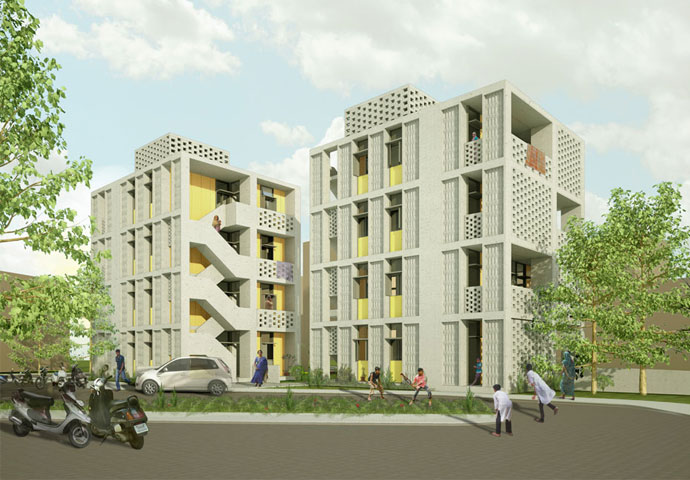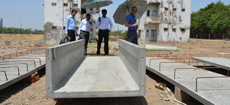Toward a Concept House for India
A component-based system whose forms respond to multiple goals for single- and multi-story house construction in India.
In order to answer a crucial housing shortage among middle class people in India, we developed Ideal Choice Homes in partnership with the Indian asset management company, Sam Circle Venture, and the Indian development company, Project Well. The project was unveiled at a press conference and workshop on mass housing, sponsored by the Royal Institution of Chartered Surveyors (RICS) in Mumbai and New Delhi in December 2011.
The search for a whole-building solution required research into all aspects of off-site fabrication, supply chain, and drivers of thermal comfort in India. We asked and answered questions about affordable cost, efficient construction, mass-customizable materials, resource conservation, thermal comfort, and owner self-sufficiency. We interrogated target market, Indian housing typologies, familial room-use patterns, development incentives, flood potential, seismic risk, air pollution, water pollution, solid waste infrastructure, labor, traditional material use per state, general material availability, and the Indian Green Building Council Green Homes Rating System.
This research established benchmarks and goals that were tracked through the project's development:
- Fabricate a reasonable percentage of a detached house off site via a process executable at a mass scale.
- Engineer a housing system, scalable vertically as well as horizontally.
- Detail material and systems connections to reduce on site construction time to four weeks.
- Provide buyers options for material mass-customization.
- Meet or exceed thermal comfort goals for a house located in India's composite climate zone.
- Meet or exceed resource conservation goals per the 2009 IGBC Green Homes Rating System.
- Provide a house at a cost of 9,500-12,000 Indian rupees/m2 (approximately 174-220 USD) located in a Tier II or Tier III city.
- Set up a supply chain for assembly, material supply, and worker training.
- Address issues related to loans, funding, and policies.
- Prepare a workable business plan that incorporates on-the-ground realities.
Then, we searched for forms that met the established goals, favoring those that met many at once—for instance, a house component design that eases transport and maintains thermal comfort, or an assembly method that reduces construction time, ensures worker safety, and spurs the creation of a skilled workforce.
We created mockups and prototypes to ensure that components met multiple goals. For example, we investigated several concrete mix designs using combinations of aggregates and fibers that are available for manufacturing in India. We built mockups to reduce a component's weight and improve its thermal performance using our own custom-designed software to calculate weight and insolation for each cast design. Following these tests, full prototype panels were constructed in a pre-casting facility in Pune, India, and in our own shop. Modeling and simulation confirmed that the house shape and component forms did indeed meet thermal comfort goals. With a tool developed in-house, we simulated the velocity, temperature, and composition of air in room-scale and urban-scale environments, and explored the sensitivity of results to changes in the spatial and temporal resolution of our design.
The result is a holistic, component-based system whose forms respond to multiple goals for single- and multi-story house construction in India. It is poised for full-scale prototyping in the Indian context.






